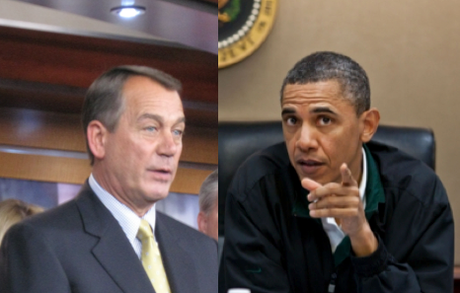
John Boehner and Barack Obama.
Well, it happened: Just like it warned, credit ratings agency Standard & Poor’s downgraded US government debt from AAA to AA+, the first time the US has been downgraded in the history of ratings on Friday.
In its report on the downgrade, S&P stated, “The downgrade reflects our opinion that the fiscal consolidation plan that Congress and the Administration recently agreed to falls short of what, in our view, would be necessary to stabilize the government’s medium-term debt dynamics. More broadly, the downgrade reflects our view that the effectiveness, stability, and predictability of American policymaking and political institutions have weakened at a time of ongoing fiscal and economic challenges to a degree more than we envisioned when we assigned a negative outlook to the rating on April 18, 2011.”
The blow stung – stocks from the US to to Europe to Asia to Israel plunged upon opening after the weekend, though the move also “perversely” increased demand for US government debt and the dollar as investors retreated to a “safe” haven, the Financial Times reported. Some are concerned that the move will trigger a rise in interest rates in America. But perhaps more painful was that S&P’s downgrade was a direct rebuke of the political theatre that attended the debt ceiling debate and eventual deal; the Obama Administration struck back at the credit ratings agency, claiming that its assessment was based on “flawed” math. S&P defended its decision, again pointing to the political gridlock that defined the debt ceiling fiasco.
Markets are still digesting the news
But, a credit downgrade, however bad for it could be for the global markets and is for American morale – there are now 18 countries and seven global corporations with better credit ratings than the world’s largest economy – is also an opportunity for some soul-searching. Whose fault was this? And is this downgrade really all that bad?
- Bad move, S&P. Some are downplaying the downgrade, while others are just angry at the credit ratings agency. Bill Miller, chairman of Legg Mason Capital, told the Financial Times that the downgrade was “precipitous, wrong and dangerous,” noting, “At best, S&P showed a stunning ignorance and complete disregard for the potential consequences of its actions on a fragile global financial system.” Government bond traders, meanwhile, are “shrugging off” the downgrade: “Many pointed to the fact that, a decade after Japan lost its AAA rating, 10-year Japanese government bonds are still yielding only 1 per cent and the yen is as strong as ever.” And then there’s the fact that the US dollar ironically remains a safe haven, despite the fact that its financial system is at the heart of the concern – currency traders are saying that the dollar could rally. At the same time, economists from all over are convinced that the ratings downgrade will have minimal impact on interest rates.
- S&P has no credibility. It’s a bit of pot and kettle: As Paul Krugam, veteran New York Times columnist noted, S&P is “the last place anyone should turn for judgments about our nation’s prospects.” S&P, after all, was one of several agencies that gave AAA ratings to mortgage-backed securities that have since turned into “toxic waste” and it also gave Lehman Brothers, the investment firm whose collapse caused a global financial earthquake, an A rating up to the month of its downfall. Even better, S&P made a $2 trillion miscalculation in its assessment of US debt, caught by US treasury officials, but decided to go ahead and downgrade anyway. “So these people are now pronouncing on the creditworthiness of the United States of America?” raged Krugman, adding, “[T]here is no reason to take Friday’s downgrade of America seriously. These are the last people whose judgment we should trust.” America does have problems – but they’re mostly political.
“The downgrade reflects our view that the effectiveness, stability, and predictability of American policymaking and political institutions have weakened,” said S&P.
- The real problem: Political brinkmanship. S&P’s downgrade was less a downgrade of American creditworthiness and more a strong rebuke of its political system, G.I. argued on The Economist’s Free Exchange blog. And it’s not America’s ability to pay that’s in question, but its willingness. “Absent the toxic politics that infected the debate, we could have hammered out a deal that stabilized the debt without squeezing the economy too much in the near term…. That is not what happened. As the fight dragged on, the leadership moved closer to the Tea Party, not the other way around. And they seem happy with the results. Why else would Mitch McConnell have promised on August 1st to do exactly the same the next time the debt ceiling must be raised? It is striking that the proponents of this strategy seem so oblivious to its impact.”
- Yep, it’s political – and it looks like S&P is blaming the Republicans. The Republicans have tried to spin S&P’s downgrade into a vindication of the party’s debt ceiling demands, but many critics are rejecting that notion. “S&P didn’t base its downgrade on a change in the U.S. fiscal and economic outlook,” said Edmund L. Andrews at National Journal. “It based it on the political game of chicken over the debt ceiling, a game that Republicans initiated and pushed to the limit, and on a growing gloom about the partisan deadlock. Part of S&P’s gloom, moreover, stemmed explicitly from what a new assessment of the GOP’s ability to block any and all tax increases…. it’s hard to read the S&P analysis as anything other than a blast at Republicans.”

